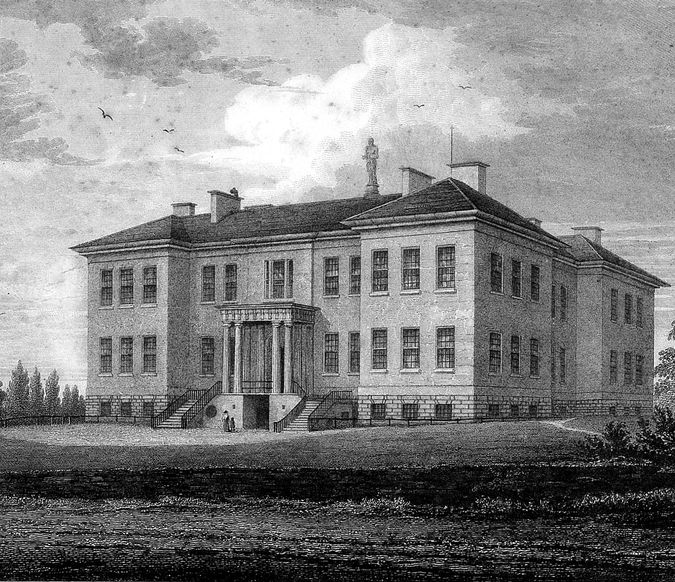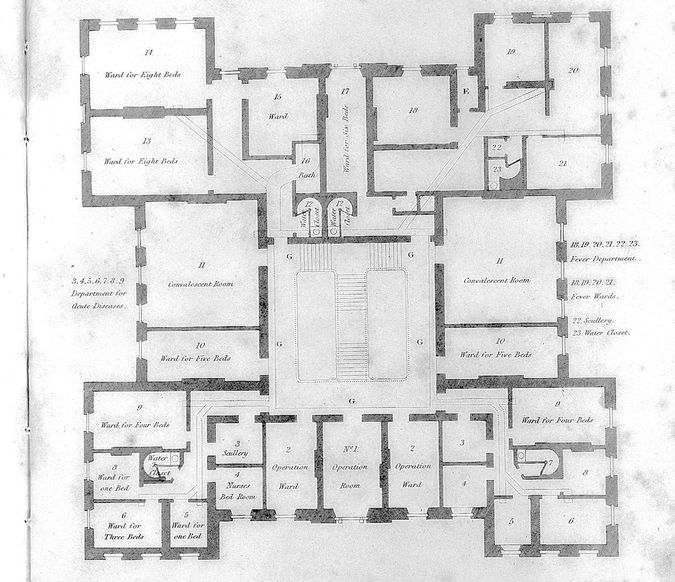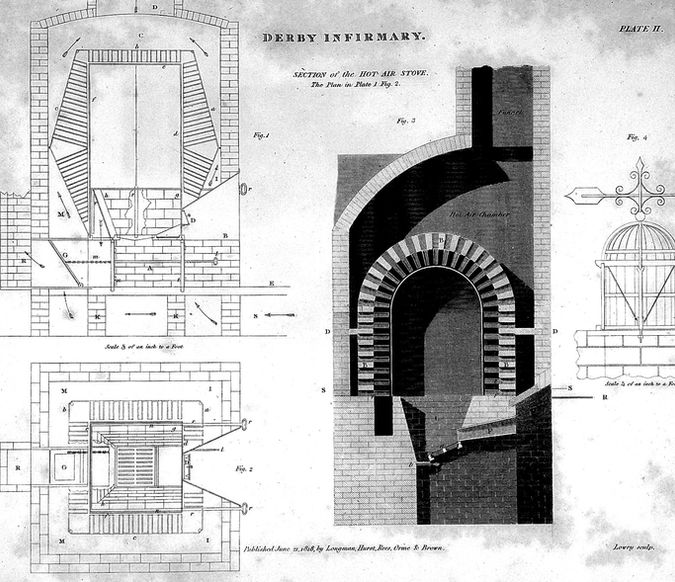
William Strutt and
The Derbyshire General Infirmary
A Brief History of Hospitals in the UK
Before the ‘age of enlightenment’ hospitals in the United Kingdom tended to have been run by the Church, in monasteries and alms houses.
But in the 18th century, that began to change.
According to Burdett’s List of Hospitals and Dispensaries, 31 general hospitals were founded in the UK between 1700 and 1802. In the East Midlands, three key hospitals were built:
-
Lincoln County Hospital in 1769
-
Leicester Royal Infirmary in 1771
-
Nottingham General Hospital 1782
Derby was somewhat lagging but that was about to change in 1803
The Derbyshire General Infirmary 1810-1891

On the 7th of Fenruary 1803, the Reverend Thomas Gisbourne, of Yoxall Lodge, in a letter to Francis Noel Clarke Mundy Esq of Markeaton, then an active magistrate for the County, suggested the erection of an Infirmary at Derby, offering to contribute to the project £5,000 left in the hands of himself and of Mr Hawkins Browne from the estate of Isaac Hawkins. Money bequeathed for benevolent purposes.
Mr Mundy communicated the proposal to his brother magistrates and to the Mayor and Corporation of Derby. He then submitted the project to the Lord-Lieutenant of the County, His Grace the Duke of Devonshire who donated £2,000 to the project.
A meeting of the leading inhabitants of the town and county was convened by the High Sheriff at the County Hall, on the 5th of April 1803. Liberal contributions (£17,215 with a further £2,592 and 18 shillings) were promised, and a subscription list established. Here are just a few of those first subscribers:
Click on a name for more information

Land was purchased from the Castle Fields estate at a cost of £200 per acre. 14 acres was purchased. William Strutt (1756-1830), the cotton manufacturer, philanthropist, inventor and architect was commissioned to build the Infirmary.
William Strutt and his Building Innovations

William Strutt, despite his limited formal education, came to be regarded as an expert in the design of fire-proof buildings, in hot-air heating systems and, following the completion of his tour de force, the Derby Infirmary, in the design of hospitals. Strutt used some of the building techniques he’d employed in his Cotton mills to the design.
The Infirmary was one of the first British hospitals to employ an iron and glass structure for the roof (the dome), iron pillars and beams, iron-framed windows, and a fire-proof ceiling over the baths.
The iron dome structure allowed six skylights to be incorporated, each consisting of three rows of glass panels, thus maximising the amount of light shining onto the central hall and staircase, a 10ft terracotta statue of Aesculapius (the Greek God of medicine and son of Apollo) designed by William Coffee stood on the top. Sadly, the statue went missing in 1890 and its whereabouts are still unknown.

The Infirmary was cubical in shape and spread over three floors. The basement story was below ground level and contained public baths, cellars, kitchens and a wash house. The middle story was elevated and approached by steps and a portico supported by four pillars made of millstone stone, sourced from a quarry at Wirksworth. Besides housing a couple of Wards, the outpatient room and chapel, it contained a boardroom, servants’ quarters and the rooms for the medical staff. The upper story was approached by a staircase leading from a spacious hall in the middle of the building.
In 1792 Strutt had devised a type of warm air stove and arrangement of flues and turncaps to warm and ventilate a mill at Belper. In Strutt's system at Derby, air was introduced by means of a four-foot wide, 70 yard long duct and heated by an iron plated cubicle "cockle" or stove in the basement, encased in brick and placed over the fire under a grate. Warm air was directed through a series of ducts throughout the three levels of the building. The smoke from the fire escaped from the cockle into the flues by passing downward through two long, narrow slits on opposite sides of the cockle.
An outlet on the roof was provided with a turncap for the escape of foul air by flues connected with all the rooms for patients, whilst a second turncap away from the main building and connected to it by an underground culvert, was controlled by the power of a vane that turned it into the wind.
The first turncap vane turned it always away from the wind. By these means, a current of air always passed through the wards.
The 15 horsepower steam engine worked a forcing pump, which raised water from a well to a cistern at the top of the building. It also gave motion to horizontal shaft that communicated with the wash house to turn the washing machine and the steam was used to warm the public baths.

Photo from the UHDB Medical Museum Collection
A laundry dried the linen by the action of warm air from the heating system, whilst wet linen was passed into the hot closet on sliding horses with grooves to run across rails. In the kitchen Strutt incorporated a more efficient roaster of his own design and a new type of steaming apparatus, which he also used at his Derby home.
Amazingly and way ahead of his time, Strutt also invented the adjustable bed mechanism after he had noticed that the nurses had great difficulty in turning over some patients without causing pain. Strutt's bed utilised a toothed wheel, ratchet and spring mechanism, allowing patients to be moved to any sideways position and held in place for comfort and easy treatment.
Staffing
Initially, the medical staff was small consisting of a matron, two nurses, a resident house apothecary and a secretary. Three physicians and four surgeons attended periodically and according to a rota of duty days for emergencies.
As was common in Georgian general hospitals, apart from emergencies, patients could be admitted only through the recommendation of subscribers or senior medical staff. Again, as was usual, many types of patient were excluded, such as those who could afford their own treatment, pregnant women, children under the age of seven, prostitutes and those convicted of criminal offences.
The Infirmary opened on Monday 4th June 1810, and began by providing accommodation to 80 patients.
The baths were established in 1811 and were situated
to the left and right of the basement story entrance.
The baths to the left were kept at a constant 84 degrees and the baths to the right at a constant 92 degrees. A single bath cost 2 shillings, but 20 tickets transferable to members of the same family could be purchased for 20 shillings. A costly indulgence when we consider that for most of the 1800s a shilling was approximately a day’s wage for a labouring man. The baths were discontinued in 1835 as they were deemed no longer profitable.

Photo from the UHDB Medical Museum Collection
Gas was introduced in 1825, and an anatomical museum was established in 1830. In 1848 new fever wards for 40 patients was built and in 1857 £600 was spent in improving the ventilation, but this was found to be still imperfect, and in 1865 the “Nightingale Wing” with chapel, kitchens, and other buildings were built and formally opened by the then Lord Vernon on November 12th 1865. In 1891 the Infirmary’s condition had become unhealthy and after a thorough investigation, it’s demolition was decided upon.
In it’s heyday, the hospital was seen as a leader in European architecture and architects and visiting Royalty were brought to see its features. Strutt died in 1830 and was buried in the Unitarian Chapel in Friargate, Derby. The President of the Royal Society eulogised Strutt in 1831 as
"..author of those great improvements in the construction of stoves, and in the economical generation and distribution of heat, which have of late years been so extensively and so usefully introduced in the warming and ventilation of hospitals and public buildings".
Want to know more? Click image to read "The Philosophy of Domestic Economy" by Charles Sylvester, 1819
(public domain)







